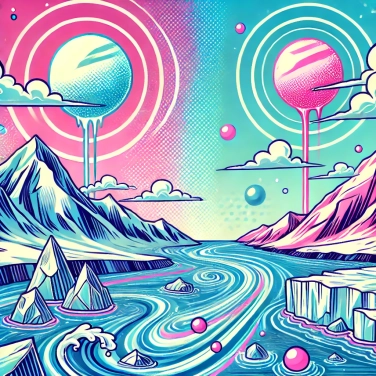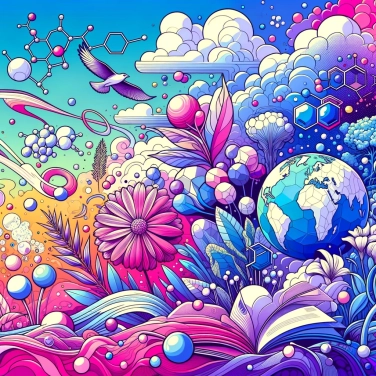Ice caps play a crucial role in regulating the Earth's climate as they reflect some of the sunlight, thus limiting the absorption of heat by the Earth and helping to maintain the planet's overall temperature.

Ice caps act as a huge natural mirror, their white surface reflecting a large part of the sun's rays directly back into space. This phenomenon is called albedo: it is particularly high for snow and ice, unlike the oceans and dark land that absorb much more heat. As a result, these massive ice blocks prevent the Earth from warming too quickly by limiting heat absorption. If ice caps decrease in size, a less reflective surface replaces them, such as the sea or dark land, which heat up much faster when exposed to the sun. Consequently, the less ice there is, the faster the planet warms, and the faster the planet warms, the more ice melts. A true vicious cycle!
The ice caps, as they melt, release enormous amounts of cold freshwater into the oceans. As a result, this disrupts the salinity and especially the density of seawater, directly influencing ocean currents. These currents, like the Gulf Stream, act somewhat like underwater conveyor belts, transporting heat from one region of the globe to another. If the density of the oceans changes too quickly, these currents slow down or alter their trajectory, leading to a redistribution of heat on a global scale. In other words, some regions could become abnormally cold or hot, completely upheaving our regional and global climates.
The melting of ice caps directly leads to a rise in sea levels, with not very cheerful consequences for coastal regions. Today, it is estimated that the level is rising by a few millimeters per year on average, and that is already enough to cause serious concern. This gradual rise could reach several dozen centimeters by the end of the century, causing frequent flooding in inhabited areas and forcing many populations to migrate. In the Pacific Islands, for example, entire territories are beginning to disappear underwater. Not to mention storms and hurricanes, which are becoming more violent and destructive with a higher sea level. In short, less ice means more water in our cities and major problems for coastal ecosystems.
Beneath these thick layers of ice, the frozen ground (the permafrost) contains a real climate time bomb: organic carbon trapped for thousands of years. As long as the cold persists, it remains safely stored within, but as temperatures rise and the permafrost thaws, the released carbon transforms into greenhouse gases like carbon dioxide (CO₂) and methane (CH₄). Obviously, when these gases escape into the atmosphere, they enhance global warming, triggering a vicious cycle: rising temperatures → more melting → increased gas release. Glaciers thus play the role of a climate vault, essential for keeping these toxic gases away from the atmosphere.
Ice caps act as true reservoirs of fresh water, maintaining a vital balance for ecosystems. Their abrupt melting can disrupt the salinity of the oceans, directly impacting marine species sensitive to these changes. On land, the fragile balance of many habitats also closely depends on the presence of ice: animals such as polar bears, walruses, or seals use the ice pack to rest, hunt, or rear their young. Not to mention the small organisms that are so precious, like phytoplankton, whose proliferation heavily relies on icy conditions and which form the essential food base for the entire marine food chain. In short, a disruption of ice caps directly affects biodiversity and the overall health of both terrestrial and marine ecosystems.
The Greenland ice sheet has lost an average of nearly 280 billion tons of ice mass per year over the last decade. By comparison, this represents a rise in sea levels of about 0.8 millimeters per year.
Air bubbles trapped in ice for hundreds of thousands of years allow scientists to study ancient atmospheric conditions and gain a better understanding of the climatic changes of our planet.
Some microbial species, adapted to the extreme cold of ice caps, have survived for hundreds of thousands of years. They are fascinating examples of life's adaptation to very harsh conditions.
The ice caps contain nearly 70% of the Earth's total freshwater. Their massive melting could significantly alter access to freshwater in many regions of the world.
An ice cap is a vast expanse of ice covering a continental surface, whereas a glacier is a smaller, moving mass of ice that typically flows down a valley or mountainside. Ice caps cover much larger areas and significantly impact global climate patterns.
The albedo effect refers to the ability of a surface to reflect solar radiation. Ice caps, due to their bright white color, have a high albedo, thus reflecting a large amount of solar energy back into space and limiting global warming.
The rise in sea levels caused by the melting of ice caps poses a serious risk to coastal areas, potentially leading to the permanent flooding of certain regions, the loss of natural habitats, and an increase in the frequency and severity of extreme weather events such as storms and cyclones.
Yes, the ice caps contain not only carbon dioxide but also methane and other atmospheric gases trapped in air bubbles locked in the ice for thousands or even millions of years. Thus, accelerated melting could release these gases and amplify global warming.
Yes, the ice caps play a crucial role in regulating global ocean circulation by releasing cold freshwater as they melt. This influences ocean salinity and temperatures, thereby impacting major ocean currents such as the Gulf Stream and the thermohaline circulation.
Although some ice cap melting is already short-term irreversible, global measures such as drastically reducing greenhouse gas emissions, transitioning to renewable energy, and preserving ecosystems can significantly slow down their future melting.

No one has answered this quiz yet, be the first!' :-)
Question 1/5